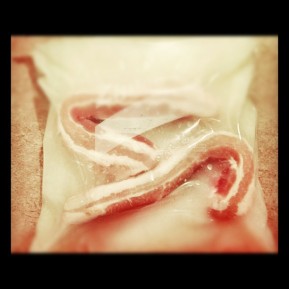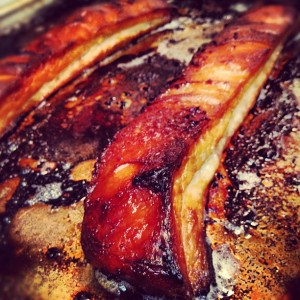
I happened to be at an Asian grocery the other day and noticed that pork belly was on sale. Since I still had some shio koji left, I thought marinating it in pork belly might be a good 2nd project for the salty substance.
I had been meaning to try emulating the ubiquitous Momofuku pork belly buns. Yes, they are everywhere, but heck, it’s because they are so sublimely perfect–an Asian slider of pork belly goodness with a crunch of veg enveloped in a pillowy white, clamshell-shaped bun.
We copied them at moto-i, and they were extremely popular. The two-bite brownie of the slider/mini-burger world, the buns (or baos) have their roots in Taiwanese food. Baohaus in NYC offers the ‘gua bao’ in a more traditional way (along with some cool fusion twists), as you would see at a night market in Taipei. The Momofuku version is definitely a fusion, an homage to what is considered old skool. I can certainly appreciate both sides of the bao coin.
Since I do like the Momofuku hoisin sauce version (What fatty meat roasted with hoisin and garnished with savory green onions isn’t mouth-wateringly good?), I thought I would attempt to make my own pork belly gua bao.
I had about a pound of the leanest pork belly I could find and marinated the meat in a shio koji brine. Basically I took all the shio koji I had left (about 1.5 cups, some sugar and 4 cups of water) and placed it in a Ziplock bag overnight. If you are using shio koji as a salt replacement, a good rule of thumb is whatever the amount of salt is required, double it for shio koji. The shio koji is salty (but less salt is actually used) and adds a mellow, sweet depth that regular salt does not possess.
I admit, I cheated and went to one the many frozen dim sum shops in town and picked up some of the clamshell baos. I purchased 20 for about $9. I thought I got ripped off since there wasn’t a price for the baos at all in the store, as prices seemed to be randomly calculated by the little Taiwanese lady at the counter. She told me 50 cent apiece, but since she charged me only $9, I suspect her math was a bit off. “It’s probably what it should be in term of price,” I muttered to myself. She did tell me the cheaper Szechuan rectangular versions were essentially the same as the clamshell style, in terms of taste.
Using my Japanese mandoline to thinly slice the cucumbers, carrots and daikon was such a pleasure! I love that contraption, but you have to give it some respect or it will easily slice off several layers of skin before you can cry out loud in knowing agony (The ‘Why did I not use the finger guard’ agony?).
I pickled all the veg with some mirin, rice vinegar, salt and a touch of water–leaving overnight also.

Roasted pork belly is so darn good, only because it’s so damn fatty. It’s hard not to appreciate the simple beauty of pork meat commingling with glistening layers of fat. Chinese BBQ pork belly with the crunchy skin on, has got to be one of the greatest pleasures in life. You only live once right?!
I placed the pork belly on a cookie sheet with a relatively high lip. Poured some broth and some water onto the pan and tightly covered up the pork belly in tinfoil.
The divine aromatics of roasted pig filled the room. Oh yes, that is some meaty manna from heaven!
2.5 hrs later, I took the tinfoil off and left the pan in for another 20 minutes to crisp up the top fatty layer of the roasted pork.
I was so excited by how good it looked, I quickly steamed the baos, got out the hoisin sauce and prepared the veggies. They look pretty good, no?

They were tasty. Yum, wow–words cannot describe how surprised I was that they turned out so well and how easy it all was. Even my mom who normally abhors eating any sort of fat, ate one. My father, who nary utters a word these days (he’s not well), uttered, ” Oh that was good.”
So yes, pork belly in the belly makes people happy it would seem!

